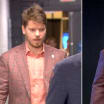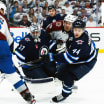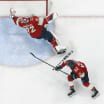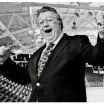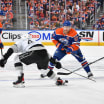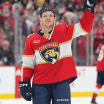The two women looked at each other, disbelief wrapped in joy. Nearly half a century after Barbara Underhill and Tracy Tutton had met in seventh grade as aspiring figure skaters attending the same school, they were now standing on the ice at Amalie Arena, together, as the Tampa Bay Lightning celebrated winning the Stanley Cup.
Former figure skaters finding 'surreal' success as NHL skating coaches
Longtime friends Underhill, Tutton, Braid had hand in Lightning Cup win after unlikely journey
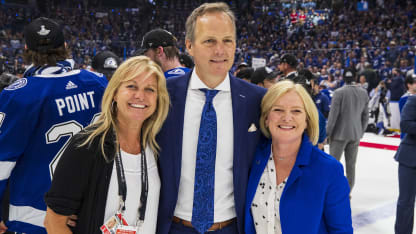
© Scott Audette/Getty Images
The emotions came through, in tears, in hugs, in eyes shining with the knowledge that their boys, "a whole team of sons," as Tutton put it, had just won the Cup for the second straight season. But it was more than that. They had done it together, an unexpected outcome in an unexpected career in an unexpected sport, and this time they were allowed on the ice to celebrate.
"It was just a surreal moment of pride and happiness and emotion," said Tutton, who, like Underhill, had to watch their achievement from afar in 2020 because of the restrictions due to the COVID-19 pandemic. "And so some of it, we didn't speak it as much as look at each other and know what each other was feeling."
The third member of their trio -- longtime friends who all made the transition from figure skating to hockey as NHL skating coaches and now are consultants to various teams in the League -- was not there on the ice that night, July 7. But even Dawn Braid had a hand in that season and that moment, having long tutored then-Lightning forward Barclay Goodrow as a private client.
It was an achievement that three of the most in-demand skating coaches in the NHL have long been striving toward, a celebration of their work, a moment of togetherness, of friendship, and an acknowledgement of just how unlikely of a journey it's been.
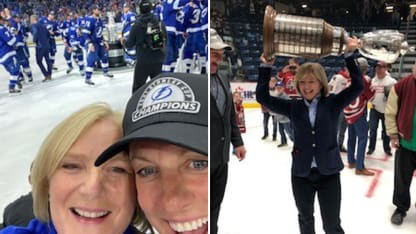
Because back when they met -- in middle school for Underhill and Tutton, and shortly thereafter through skating for Braid -- the goal was gold medals. The Stanley Cup wasn't even a thought.
And yet, here they were.
"I just can't even explain how amazing it's been for the three of us," Tutton said. "You look back to when we were teenagers, we would never have understood if we said this is what we'll be doing together. It's like, what?"
\\\\
The NHL keeps changing. The game is faster; the skaters are more skilled; the acceptance is growing. Teams employ skating coaches, using them everywhere from development camps to regular practices, from their NHL teams to their prospects. And Underhill, Braid and Tutton are among the best.
"I have a lot of respect for her, for her teachings, the way she operates, the clientele that she's helped out," Boston Bruins forward Taylor Hall said of Braid. "The first summer I worked with her was the summer before I won the Hart Trophy (for the 2017-18 season) and I feel like we accomplished a lot.
"We developed a really good relationship where she can be critical of parts of my game that I need to work on. I feel like earlier in my career I used to be maybe a tad reckless with my skating and now I feel like it's much more controlled and just better for my overall game. And I have a lot to thank her for, for that."
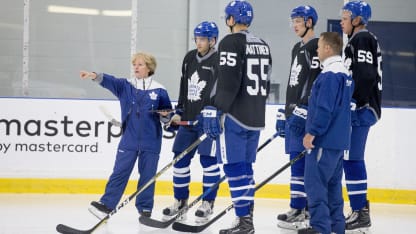
© Carlos Osorio/Getty Images
He's not alone.
Each of the three has made her mark on the NHL, from Underhill developing important strategies in early days working with the Guelph Storm of the Ontario Hockey League, when she used a clunky video camera to compare her clients' skating to that of NHL great Mike Gartner, to Underhill, Braid and Tutton adopting cutting-edge techniques that have helped players like Lightning forward Brayden Point, who publicly attributed much of his improvement since being drafted to Underhill's tutelage.
"When I first started, there were very few, especially women, but technical skating-specific people -- there were lots of skills coaches and lots of different areas, but technical skating coaches, there were very few," Underhill said. "So it was all pretty new.
"But I think, because the game was changing so drastically at that time, teams because desperate almost for that knowledge. And so slowly we became a part of the culture."
They have helped deepen the relationship between figure skating and hockey, taking the tools of one sport and injecting them into another, understanding, as Tutton said, "how much of a difference it can make to a hockey player to be able to do what we can do."
It can help smooth skaters' laborious strides. It can help with injury prevention. It can help lengthen careers. It can take away one more thing for hockey players to think about while on the ice, easing the rest of their game.
"It's the best feeling in the world when a player looks at you with a smile and goes, 'Wow, that felt really easy,'" Underhill said. "You can see it in their face. … When they start to feel how good it feels when you're skating with fluidity, you're skating with balance and skating efficiently, that's huge, right?
"When you're moving well and feeling good, you just play the game better."
\\\\
Underhill didn't know that Tutton was vacationing in Mexico. The best of friends since they met at Central Park Collegiate school in Oshawa, Ontario, they hadn't spoken for a while and, yet, here they were at separate Playa del Carmen resorts at the same time in 2011, which Underhill would call "just so serendipitous."
They met up by the pool to go over their lives, where they were and what they hoped for. Tutton was frustrated and unhappy, looking for a new challenge after years of teaching figure skating at the highest levels. Underhill had already left the figure skating world, beginning her transition to hockey in 2006 after her husband, Rick Gaetz, bought the Storm and the coach asked Underhill to help out. She got on the ice and instantly knew this was her future.
Underhill suggested Tutton could do the same.
"She just jumped," Underhill recalled. "She literally just jumped at it. She was like, 'I'm in. I'm in.'"
She was the last piece to fall.
"I was already well into work in the NHL and I was like, you've got to do this," said Underhill, who invited Tutton to help work at the Lightning's next development camp after Tutton helped Braid at the Ducks' same camp. "I knew that she had such a background in teaching figure skating that she would jump into it so fast, that she would be really good at it. It happened pretty quick."
She just needed hockey skates.
Underhill recalled that she had to gently break it to Tutton that she wouldn't be able to come to development camp in her usual footwear. So Underhill handed over a pair of her old hockey skates, and Tutton raced to get comfortable before that first camp.
By then Underhill had established herself in hockey, working with the Ducks and New York Rangers before being hired by the Lightning in 2011 and Toronto Maple Leafs in 2012. She had followed in the footsteps of Braid, who had started consulting with the Maple Leafs in the mid-2000s, moving to the Ducks and Buffalo Sabres, and then to the Arizona Coyotes in 2016, becoming the first female to earn a full-time coaching role in the NHL in 2016, then working for the Calgary Flames and now the New Jersey Devils. Braid also did extensive work with private clients like Maple Leafs center John Tavares and the No. 1 pick in the 2021 NHL Draft, defenseman Owen Power. Tutton started with the Colorado Avalanche and now works with the Lightning and Detroit Red Wings.
It was a wave of former figure skaters entering the NHL, the legacy of Laura Stamm's work in the 1970s with New York Islanders forward Bobby Nystrom.
Braid was first. She started with a Junior B team her father had bought in Vaughan, Ontario, the Vaughan Raiders. Knowing that they would be an expansion team, her father wanted to try every angle, to find every advantage. Braid stepped in. It was 1984; she was 21.
"I go back to my father saying to me, 'I really think you have something here,'" Braid said. "I think you could take this to an NHL level. I think NHL players, they need that. They could use that. And I remember saying, 'Dad.' You know, I kind of laughed at it. I said, 'Really? I don't think so.'"
Her career, and the careers of her two friends, have proven just how wrong she was.
They had all had experience in helping hockey players, of being the "rabbit" during power skating drills. But this new role, this new idea of jumping from figure skating to hockey skating coaches, drew on a deep well of knowledge.
"All three of us were pairs skaters for quite some time and [learned] the whole biomechanics and science behind what you need to be aware of in your body and how you need to handle yourself on the ice in order to not be killed," Tutton said. "Because it's definitely not an easy task.
"But then, as our children got into hockey, I think we started to really take an interest in realizing this is all so connected and how much of a difference it can make to a hockey player to be able to do what we can do."
\\\\
But it had all started much earlier, long before any of the three of them had children or families, long before hockey was even a thought. It started when Underhill and Tutton were in seventh grade, when they attended school in the mornings and skated in the afternoons.
They added Braid to the mix not much later, a friendship that began by keeping in touch after skating events and was cemented one summer when Underhill was invited to crash at Braid's house, with the pair bunking in the Braid family's motor home, parked in the driveway.
They were inseparable, so tight that their families treated them like sisters. Tutton said that when she missed curfew, she wasn't the only one grounded. Braid and Underhill suffered the consequences as well.
Underhill would eventually go the furthest in skating, becoming the Canadian national champion in pairs skating from 1979 to 1983 with partner Paul Martini, skating in the 1980 Lake Placid Olympics and 1984 Sarajevo Olympics. Underhill and Martini won the 1984 World Championship.
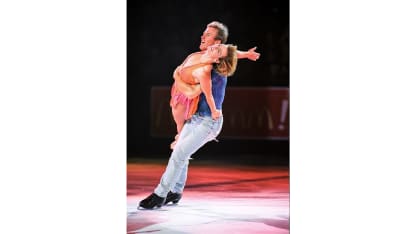
The three friends would swirl into and out of each other's lives as the years went on, two of them growing closer when the third would go away for a skating-related opportunity - the Ice Capades here, Holiday on Ice International there.
All three, who turn 58 this year, would be in one another's wedding parties, with Underhill meeting her husband at Braid's wedding. They celebrated the births of babies and mourned the death of Underhill's infant daughter, Stephanie, who drowned in a pool accident at 8 months.
They watched as figure skating achievements yielded to hockey ones. They watched as their kids joined the ranks, with Tutton's son Brodie (Red Wings) and Braid's son Mackenzie (Vancouver Canucks) entering the family business as skating coaches with NHL organizations.
"For whatever reason, we connected on every level as far as what we're passionate about and what we wanted to make a difference in," Tutton said. "We had the same sort of beliefs and understanding of everything."
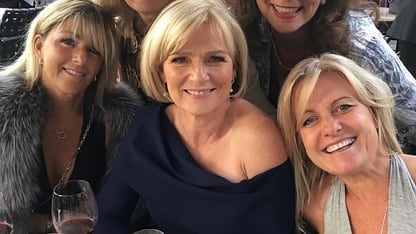
Dawn Braid, Barbara Underhill and Tracey Tutton (l-r.) have all made the transition from figure skating to NHL skating coaches and now are consultants to various teams in the League.
\\\\
They no longer stay up all night, as Braid and Tutton did during the first development camp they worked together for the Ducks, not wanting to miss a single thing. Now each has her own teams, proprietary protocols and teaching methods. They don't work together. But they have a unique bond, based on what they do and where they came from.
"It's a neat story where we are today," Braid said. "I think we all have a passion for what we do. And teaching has obviously been in our blood. Skating is what we grew up doing. I think how it's transitioned over these years is pretty incredible."
Because they all could have stayed where they were: teaching figure skating or commenting on figure skating. They could have fashioned a life that was expected.
Instead, they have done just the opposite.
"It's kind of funny when we think about growing up together," said Underhill, who has lived down the street from Braid for 20 years. "And now here we are in the NHL. It's kind of crazy. Tracy and I, when we were out on the ice after the Stanley Cup, we just looked at each other like, what? All the way from Oshawa to here. It's been crazy.
"We didn't dream this one. How would we?"
Photos: Maple Leafs photo by Getty Images/Toronto Star; figure skating photo by Stephan Potopnyk

